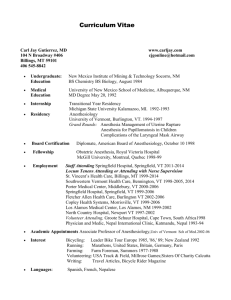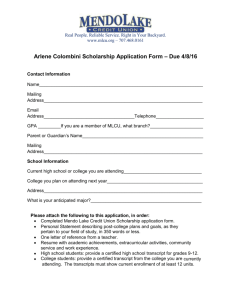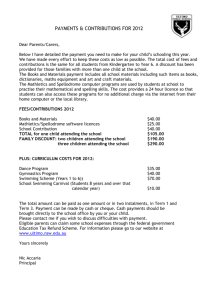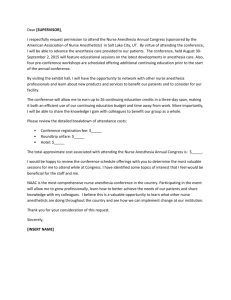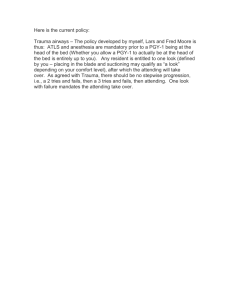Agenda 9-22
advertisement
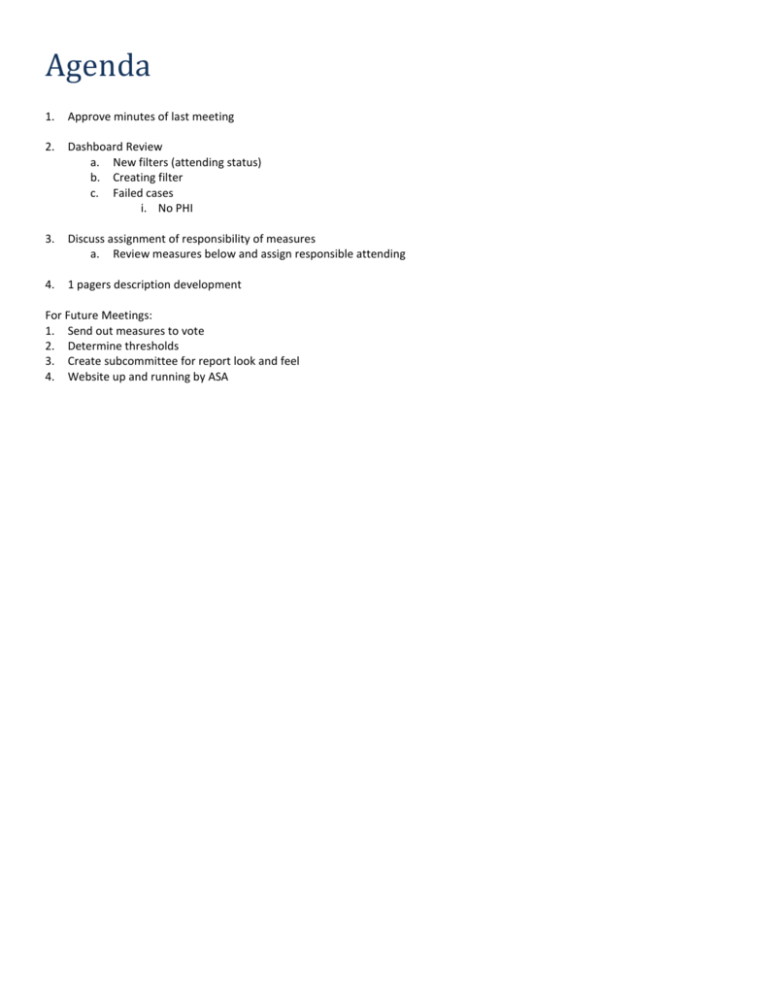
Agenda 1. Approve minutes of last meeting 2. Dashboard Review a. New filters (attending status) b. Creating filter c. Failed cases i. No PHI 3. Discuss assignment of responsibility of measures a. Review measures below and assign responsible attending 4. 1 pagers description development For Future Meetings: 1. Send out measures to vote 2. Determine thresholds 3. Create subcommittee for report look and feel 4. Website up and running by ASA Responsible Provider for Each Quality Measure Key Points: Primary anesthesia attending is currently defined as the attending with the highest total of minutes signed into the case as physically present. Thresholds can help with measures where it is not possible to attribute 100% time to a particular attending. Process of care -- SCIP 1. SCIP-INF1 – Timing of prophylactic antibiotics Responsible Provider: Attending at Surgical Incision 2. SCIP-INF10 – Perioperative normothermia and warming Responsible Provider: Primary Attending 3. SCIP-CARD2 – Continuation of beta-blockade in patients with chronic beta blockade therapy Responsible Provider: Attending at Start of Case Process of care -- Internally developed 1. Intraoperative neuromuscular blockade monitoring and treatment a. Proportion of patients receiving a non-depolarizing neuromuscular blockade medication with documentation of neuromuscular function recovery (TOF twitches) Responsible Provider: Attending at Surgery End b. Proportion of patients receiving a non-depolarizing neuromuscular blockade medication with administration of neostigmine if time from last administration to extubation is < 4 half-lives (specific to drug administered) Responsible Provider: Attending at Surgery End 2. Monitoring vigilance a. Proportion of patients without a 10 minute gap in systolic or mean arterial pressure between patient in room and patient out of room Responsible Provider: Attending at time of event 3. Discretionary transfusion management a. Patients receiving PRBC at all. Responsible Provider: Attending at time of event b. Patients receiving PRBC at all with a measured and documented hematocrit or hemoglobin within 60 minutes. Responsible Provider: Attending at time of event c. Patients receiving PRBC with a first post anesthesia end (within 6 hours) hematocrit > 32.0 . Responsible Provider: Attending at time of last PRBC transfusion d. Intraoperative hematocrit or hemoglobin nadir. Responsible Provider: Attending at time of test. 4. Glucose management a. Patients with perioperative glucose > 250 (between anesthesia start -2 hours and anesthesia end +2 hours) with an insulin bolus or infusion or glucose recheck. Responsible Provider: Attending at time of event b. Patients with insulin given (between anesthesia start and anesthesia end), recheck within 120 minutes (anesthesia end + 2 hours). Responsible Provider: Attending at time of event c. Patients with glucose < 60 (between anesthesia start-2 hours and anesthesia end) with a glucose recheck and treatment with dextrose containing solution (between anesthesia start and anesthesia end + 2 hours). Responsible Provider: Attending at time of event 5. Intraoperative ventilator management a. Patients without sustained intraoperative tidal volume > 10 ml/kg ideal body weight for 10 continuous minutes or greater b. Patients without sustained intraoperative tidal volume > 10 ml/kg ideal body weight for 20 minutes or greater Responsible Provider: attending at time of event 6. Fluid management a. Patients without administration of albumin (5%, 25%, 10%) between anesthesia start and end b. Patients without administration of hetastarch, pentastarch, or voluven between anesthesia start and end Responsible Provider: attending at time of event e Postoperative nausea and vomiting prophylaxis in patients undergoing general anesthetic with inhalational anesthesia a. Patients with administration of 2 or more classes of antiemetics between anesthesia start-6 hours to anesthesia end (5HT3 antagonist, steroids, phenothiazine, IM ephedrine, butyrophenone, antihistamine, or anticholinergic) Responsible Provider: attending at end of case 7. Clinical outcome 1. Medication overdosing a. Any patient receiving any dose of naloxone b. Any patient receiving any dose of flumazenil Responsible Provider: Primary Attending 2. End organ damage or failure a. Reintubated in recovery room or operating room b. Postoperative troponin-I > 1.00 within 4 postoperative days c. Postoperative Stage I, kidney injury (KDIGO criteria) i. 1.5 x baseline serum creatinine (measured within 60 preoperative days) observed in first 7 postoperative days ii. 0.3 mg/dl rise in creatinine within 48 hours Responsible Provider: Primary Attending 3. Pain management a. Peak pain score in recovery <= 5 b. Peak pain score in recovery <= 8 Responsible Provider: Primary Attending Exploratory variation in care analyses 1. Anesthesia technique a. Patients with an arterial line b. Patients with a central venous catheter c. Patients receiving a general anesthetic d. Patients receiving a Peripheral nerve block e. Patients receiving an epidural f. Patients receiving a spinal g. Patients receiving a spinal and a GA Responsible Provider: Attending at Anesthesia Start
